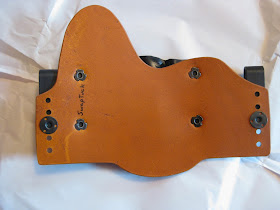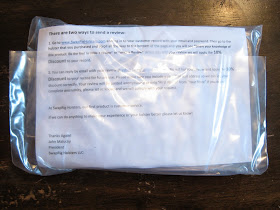A few weeks ago I saw a reference to a new, to me, holster – SwapRig. I have seen and tried many holsters over the years but this was a new name for me, so I traveled over to their website for a look. While the basic design is similar to the ordinary leather/kydex hybrid holster, SwapRig's owner and holster maker, John Malucky, has come up with a unique way to offer a very good holster, good concealment and comfort, quality of materials and workmanship plus, and this is where it gets interesting, the ability to use one SwapRig holster to accommodate hundreds of guns. That's right, hundreds of handguns.
Got my attention.
 |
| SwapTuck set up for a Ruger SR9c |
 |
| SwapTuck with the shell removed. You could now slip in any of John's shells for practically any other handgun, tighten the four screws in the rails, and you have a 'new' holster. |
My carry handguns range from a Ruger SR9c to a Ruger LCP – two significantly different sized guns. I have, of course, different holsters for each. I was intrigued by the idea that I could buy one Swap Rig, say for the LCP, and also carry the SR9c in the same rig. It works like this. John makes a kydex shell for many different handguns that will exactly replace the shell on any Swap Rig holster chassis. Loosen the four screws holding a shell, slip it off the rails on the holster chassis, slip on a different kydex shell for a different handgun, tighten the screws and shazam! you have a holster that will precisely hold that other gun. And the shells cost $18.75 each.
Really.
I did exactly that with the LCP holster. (See photo below.) I will say that the chassis – the leather component of the holster – is made wider to cover more surface area for larger guns than for smaller ones, but other than that, it works just fine. I often prefer a smaller backing area on double-clip hybrids anyway, and the SwapRig system allows me to select the size of the holster I prefer for the style of carry I'm interested in, and use it for any gun I happen to have. Nice. Very nice.
John was kind enough to provide a few holsters for me to try out and report on here. I have three different sizes and styles of holsters, two of which also have the capability to be carried IWB or OWB. I have shells for the LCP, SR9c and the Ruger SR22-P. I'll report on those as we go along, but I would note now that changing between OWB and IWB is simply done by including leather belt loops on the back side of the small holster, and slots in the leather for the medium sized holster. It's merely a matter of removing the clips, which is easily done with the great "T" handled Allen wrench John includes with each holster.
When John's package arrived I was in for another pleasant and unusual surprise. Customer service. That's a concept that is often more lip service than actual practice, but not with John. I've received holsters that have been dropped into a thick envelope and sent in the mail. None have been actually mangled, but often I receive only an envelope or a box containing a holster. That's it. I opened John's box to find all of the holsters individually and neatly wrapped along with a comprehensive set of instructions, the necessary tool you will need, and a kydex backing plate for those who might prefer additional retention on a holster. (Mine definitely don't need that, but if I wanted it, John supplies the means to achieve it easily.)
See the photos below for a look at what you get and how it's packaged for you. Outstanding.
 |
| An explanation of the different holsters, and instructions for set up, use and swapping new shells. |
 |
| The CargoPack, for cargo pants pocket carry. |
 |
| The CargoPack holster. |
 |
| For example, this is how the SwapTuck arrived. |
 |
| Unwrapping the SwapTuck reveals this. |
 |
| The MiniSwap IWB & OWB holster for the Ruger LCP, with a shell for the Ruger SR9c. Note that the shell for the larger gun fits exactly on the MiniSwap backing. |
Obviously, I am impressed with the idea, the quality of the components and way in which John makes them come together, and with the idea that one does not have to buy a separate holster for each gun, or for a gun that will sometimes have a light and or laser attached, and sometimes not. One of the issues with lasers is the need to buy yet more holsters to replace your other non-laser holsters. With SwapRig, this can be easily and inexpensively done.
I will be putting these holsters, and others I have collected for a comparison evaluation, over the next few months, reporting on what I find. Holsters have to be worn and used for a period before other weaknesses or strengths come to light, so my evaluations won't be complete until I've given each of them a thorough test run. Stay tuned.
See SwapRig holsters at: http://www.swaprigholsters.com




